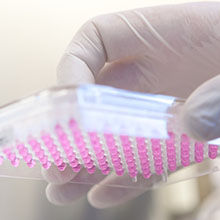New 3D test system for breast cancer radiosensitizing drugs
Radiation therapy is an important part of breast cancer treatment. Sometimes, however, tumor cells become increasingly resistant to radiation damage. Now, scientists of Helmholtz Zentrum München have developed a 3D microtissue-based screening system which, for the first time, enables them to test which chemotherapeutic drugs can resensitize breast cancer cells to radiation.

Picture: Hanging Drop System for the production of 3D micro tissue
InSphero AG (2014)
The team of researchers led by Dr. Nataša Anastasov, head of the research group ‘Personalized Radiation Therapy’ at the Institute of Radiation Biology, created multicellular three-dimensional spheroids containing a mix of breast cancer cells and connective tissue cells. As Anastasov explained, “In conventional cell culture, cell growth is two dimensional, which does not adequately reproduce the characteristics of a tumor in the living organism.” Using the new screening system, the scientists can treat the cancer cells both with various chemical compounds and with radiation to determine the effects – and that in 3D. In their study the researchers collaborated closely with the ‘Assay Development and Screening Platform’ at Helmholtz Zentrum München and the Munich-based Sirion Biotech GmbH and the Swiss InSphero AG.
The trick: fluorescent cells in hanging drops
“In our system, up to 96 wells containing microtissue spheroids can be simultaneously monitored by a computer,” said co-author Dr. Ines Höfig, explaining the fundamental principle. “For this purpose, the 3D-microtissue spheroids were grown in a hanging drop culture on the underside of a special perforated plate. After a few days, these were transferred onto an assay plate.” Her colleague Vanja Radulović added: “Because the breast tumor cells and the connective tissue cells have been labeled with different fluorescent markers, they fluoresce in different colors. A software program can thus capture precisely how each of the spheroids reacts to the treatment.”
To confirm their method, the scientists tested the properties of several drugs which are already used in tumor therapy. The drug vinblastine proved to be the most effective in combination with radiation. In the future, the researchers plan to expand their system by adding other components of the tumor environment such as stromal or immune cells in order to optimally simulate the situation in the patient.
Prof. Dr. Michael Atkinson, director of the Institute of Radiation Biology, views the findings of his colleagues with optimism: “For the first time a convenient 3D test for high throughput screening is available with which new drug compounds developed to resensitize tumor cells to radiation treatment can be tested. This will speed up future initiatives for drug development and will also enable the screening of established drugs in combination with radiation.”
Original publication
Anastasov, N. et al. (2015). A 3D-microtissue-based phenotypic screening of radiation resistant tumor cells with synchronized chemotherapeutic treatment, BMC Cancer
Original publication
Anastasov, N. et al. (2015). A 3D-microtissue-based phenotypic screening of radiation resistant tumor cells with synchronized chemotherapeutic treatment, BMC Cancer
Organizations
Other news from the department science

Get the analytics and lab tech industry in your inbox
From now on, don't miss a thing: Our newsletter for analytics and lab technology brings you up to date every Tuesday. The latest industry news, product highlights and innovations - compact and easy to understand in your inbox. Researched by us so you don't have to.






















































